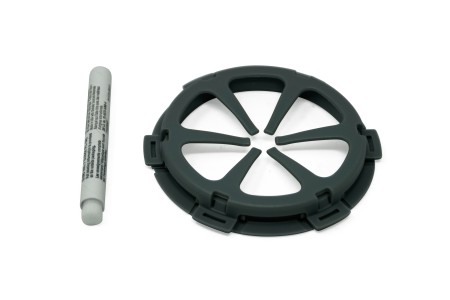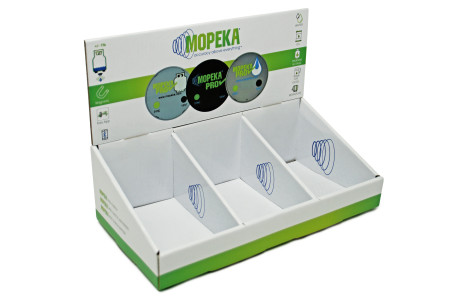- Product description
- Media & Downloads
- Accessories
The Mopeka Check PRO sensor is suitable for all grey and drinking water tanks in motorhomes, campers or caravans. The water level can be conveniently read via the app or a monitor. When using the Mopeka gas sensor at the same time, the gas and water levels can be monitored centrally in a single app
The Mopeka Water PRO sensor combines advanced ultrasonic technology with exceptionally precise measurement performance
Compatible water tanks: All grey and drinking water tanks with a flat bottom - suitable for plastic and metal tanks with a total height of less than 48? (approx. 120 cm).
Installation: Fastened using an adhesive frame (not included), which is attached to the tank floor with permanent adhesive. All necessary preparation materials are included in the scope of delivery.
Level indicator via Bluetooth: Via the free Mopeka Co-Pilot App on your smartphone or tablet.
Also compatible with the Mopeka WiFi Bridge for remote monitoring via the app
Scope of delivery: 1 Pro sensor (adhesive frame optionally available)
Power supply: CR2032 battery (included in the scope of delivery)
Safety instructions and warnings
Safety and warning information for Mopeka ultrasonic sensors with CR2032 battery
Introduction: Please read these safety instructions and warnings carefully before installing or using the Mopeka ultrasonic sensor. Follow the instructions to ensure safe use and avoid potential hazards.
1. general safety instructions
- Read the instructions: Keep these instructions for future reference and read them completely before using the device.
- Children: Keep the device and the CR2032 battery out of the reach of children as the battery can be swallowed and could cause serious injury.
2. warnings about the battery
- Ingestion hazard: CR2032 batteries can cause serious internal injury if swallowed. Seek medical attention immediately if the battery is swallowed.
- Explosion and fire hazard: Do not charge, disassemble or dispose of the battery in a fire. There is a risk of explosion and fire.
- Avoid short circuits: Ensure that the battery does not come into contact with metallic objects to avoid short circuits and overheating.
3. environmental and operating conditions
- Recommended environment: Only operate the sensor within the specified operating conditions (temperature range and humidity limit). Extreme environmental conditions such as high humidity or temperatures can impair sensor performance.
- Protection against chemicals: Do not expose the sensor to aggressive chemicals or corrosive substances, as these can damage the electronics.
4 Mounting and mechanical stability
- Mounting instructions: Ensure that the sensor is stable and correctly mounted to avoid mechanical damage. Incorrect installation can lead to measurement errors or failure of the sensor.
- Stable mounting surface: The sensor should not be installed on unstable or highly vibrating surfaces to ensure measurement accuracy.
- Flow direction: Ensure that the flow direction of the sensor is installed correctly according to the instructions on the device.
5 Electrical safety during installation and maintenance
- Safety measures during installation: Only install the sensor with clean and dry contacts to prevent short circuits. Electrical safety precautions must be observed during all installation and maintenance work.
- Proper installation: Installation and maintenance of the sensor should only be carried out by qualified personnel to ensure safe operation of the sensor.
6 Battery safety and correct handling
- Correct polarity: Ensure the correct polarity (+/-) when inserting the battery to prevent damage to the device.
- Replacement by qualified personnel: If the battery needs to be replaced, it is recommended that the replacement is carried out by qualified personnel to avoid damage.
- Temperature and sunlight: Avoid exposing the sensor and battery to direct sunlight or high temperatures to reduce the risk of overheating.
7 Storage and disposal
- Safe storage: Keep the sensor and spare batteries out of the reach of children and in a dry, cool place to prevent corrosion or battery leakage.
- Disposal of batteries: Never dispose of empty or damaged batteries in household waste. Instead, take them to an authorised collection point for batteries or a collection point to avoid environmental and health risks.
- Environmentally friendly disposal of the sensor: Dispose of the device in accordance with the applicable guidelines for waste electrical and electronic equipment (WEEE). Remove the battery before disposal and dispose of it separately.
8. maintenance and inspection of the sensor
- Regular inspection: Check the sensor every six months for visible damage, soiling or signs of wear.
- Cleaning: Use a soft cloth and mild detergent to clean the sensor. Do not use harsh chemicals or abrasive cleaners as this may damage the sensor.
- Replacement in case of damage: Replace the sensor immediately if visible damage or signs of wear are detected.
Manufacturer contact information
Manufacturer Contact
Mopeka Products, LLC
1223 Industrial Drive, Suite A
New Braunfels, TX 78130
USA
EU Contact
HybridSupply GmbH
Roggenhorsterstr. 9b
23556 Lübeck
Germany




